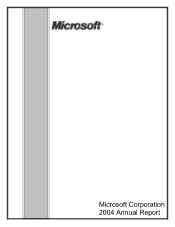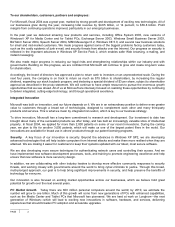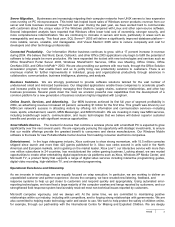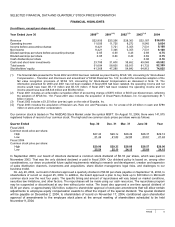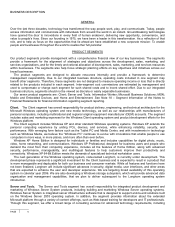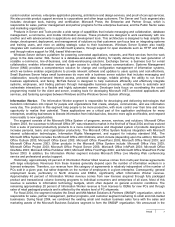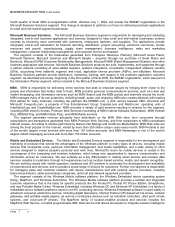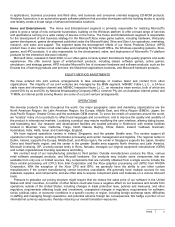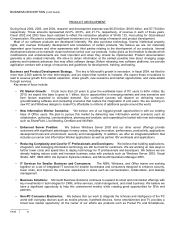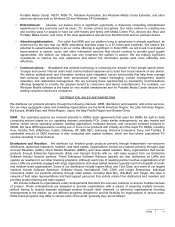Microsoft 2004 Annual Report Download - page 9
Download and view the complete annual report
Please find page 9 of the 2004 Microsoft annual report below. You can navigate through the pages in the report by either clicking on the pages listed below, or by using the keyword search tool below to find specific information within the annual report.
PAGE 9
in applications, business processes and Web sites, and business and consumer oriented mapping CD-ROM products.
Windows Automotive is an automotive-grade software platform that provides developers with the building blocks to quickly
and reliably create a broad range of advanced telematics solutions.
Home and Entertainment. The Home and Entertainment segment is primarily responsible for realizing Microsoft’s
plans to grow a range of new consumer businesses, building on the Windows platform to offer a broad range of services
and applications running on a wide variety of devices in the home. The Home and Entertainment segment is responsible
for the development of and business strategy for the Microsoft Xbox video game system, including hardware, third-party
games development, games development published under the Microsoft label, Xbox and Xbox Live operations, marketing,
research, and sales and support. The segment leads the development efforts of our Home Products Division (HPD)
product lines. It also carries out all retail sales and marketing for Microsoft Office, the Windows operating systems, Xbox,
games, and HPD products. It is also responsible for the development, sales, and deployment of Microsoft’s TV platform
products for the interactive television industry.
Microsoft Xbox, released in fiscal 2002, is our video game console system that delivers high-quality graphics and audio
experiences. We offer several types of entertainment products, including classic software games, online games,
simulations, and strategy games. HPD includes Microsoft’s line of consumer hardware and software products, such as the
Encarta line of learning products and services, the Macintosh applications business, and Microsoft hardware products.
EQUITY METHOD INVESTMENTS
We have entered into joint venture arrangements to take advantage of creative talent and content from other
organizations. The majority of our joint ventures are managed by the MSN segment. MSNBC Cable L.L.C., a 24-hour
cable news and information channel and MSNBC Interactive News L.L.C., an interactive news service, both of which are
owned 50% by us and 50% by National Broadcasting Company (NBC); ninemsn Pty Ltd, an Australian internet portal; and
T1MSN, an internet portal serving Mexico are some of our joint venture arrangements.
OPERATIONS
We develop products for sale throughout the world. Our major geographic sales and marketing organizations are the
North American Region; the Latin American Region; the Europe, Middle East, and Africa Region (EMEA); Japan; the
Asia-Pacific Region; Greater China; and the worldwide OEM channel. To serve the needs of customers around the world,
we “localize” many of our products to reflect local languages and conventions, and to improve the quality and usability of
the product in international markets. Localizing a product may require modifying the user interface, altering dialog boxes,
and translating text. Our research and development facilities are located primarily in Redmond, with smaller facilities
located in Mountain View, California; Fargo, North Dakota; Beijing, China; Dublin, Ireland; Vedbaek, Denmark;
Hyderabad, India; Haifa, Israel; and Cambridge, England.
We have regional operations centers in Ireland, Singapore, and the greater Seattle area. The centers support all
operations in their regions, including information processing and vendor management and logistics. The regional center in
Dublin, Ireland, supports the Europe, Middle East, and Africa region; the center in Singapore supports the Japan, Greater
China and Asia-Pacific region; and the center in the greater Seattle area supports North America and Latin America.
Microsoft Licensing, GP, a wholly-owned entity in Reno, Nevada, manages our original equipment manufacturer (OEM)
and certain organizational licensing operations and billing.
We contract most of our manufacturing activities to third parties. Outside manufacturers produce the Xbox, various
retail software packaged products, and Microsoft hardware. Our products may include some components that are
available from only one or limited sources. Key components that are currently obtained from a single source include the
Xbox central processing unit (CPU) from Intel Corporation and the Xbox graphics processing unit (GPU) from NVIDIA
Corporation. With the exception of the Xbox CPU and GPU, we generally have the ability to use other custom
manufacturers if the current manufacturing vendor becomes unavailable. We generally have multiple sources for raw
materials, supplies, and components, and are often able to acquire component parts and materials on a volume discount
basis.
Pressure to globalize our pricing structure might require that we reduce the sales price of our software in the United
States and other countries. A number of other factors could also have a negative effect on our business and results from
operations outside of the United States, including changes in trade protection laws, policies and measures, and other
regulatory requirements affecting trade and investment; unexpected changes in regulatory requirements for software;
social, political, labor, or economic conditions in a specific country or region, including foreign exchange rates; difficulties
in staffing and managing foreign operations; and potential adverse foreign tax consequences. We hedge a portion of our
international currency exposures, thereby reducing our overall translation exposures.

